University Report: Incidence and Management of Childhood Obesity in UK
VerifiedAdded on 2020/04/15
|13
|3636
|82
Report
AI Summary
This report delves into the critical issue of childhood obesity in the United Kingdom, examining its incidence and management strategies. The study begins with an overview of the prevalence of obesity among children in the UK, highlighting the associated health risks and the economic burden on the National Health Service. The author then reviews six academic articles to identify common themes, including factors contributing to obesity (environmental and commercial), serious health concerns, policy initiatives, barriers to healthy eating, and the roles of schools and families. The report also explores leadership, historical, and health systems approaches to understanding the issue. Furthermore, it analyzes UK government policy initiatives, such as the Soft Drink Industry Levy, evaluating their effectiveness in reducing childhood obesity. The report concludes with recommendations for improved strategies, emphasizing the need for consistent messaging, inventive strategies to overcome barriers to a healthy lifestyle, and coordinated efforts across various settings to promote healthy eating and physical activity. The report underscores the importance of addressing childhood obesity through comprehensive, multi-faceted approaches involving government, schools, families, and the private sector.
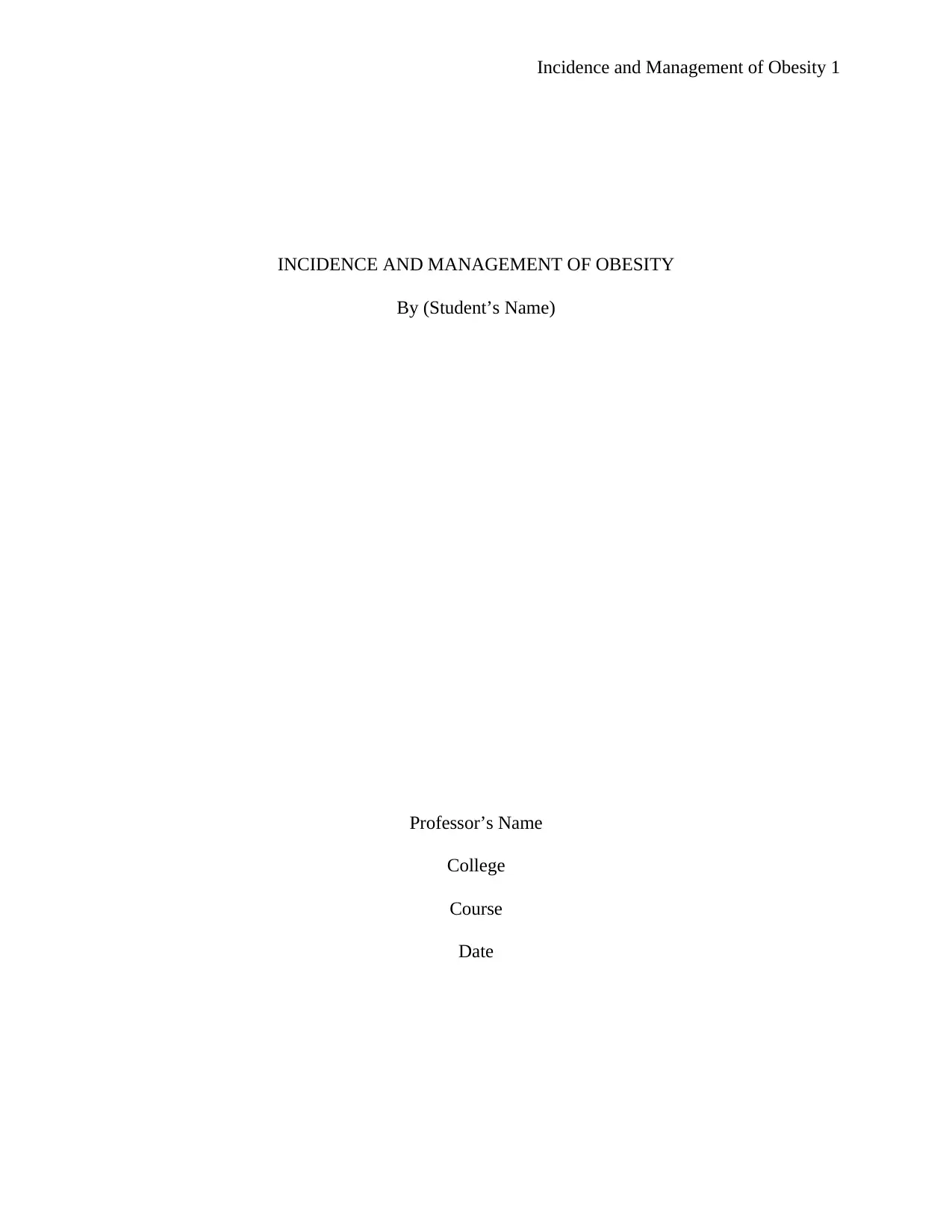
Incidence and Management of Obesity 1
INCIDENCE AND MANAGEMENT OF OBESITY
By (Student’s Name)
Professor’s Name
College
Course
Date
INCIDENCE AND MANAGEMENT OF OBESITY
By (Student’s Name)
Professor’s Name
College
Course
Date
Paraphrase This Document
Need a fresh take? Get an instant paraphrase of this document with our AI Paraphraser
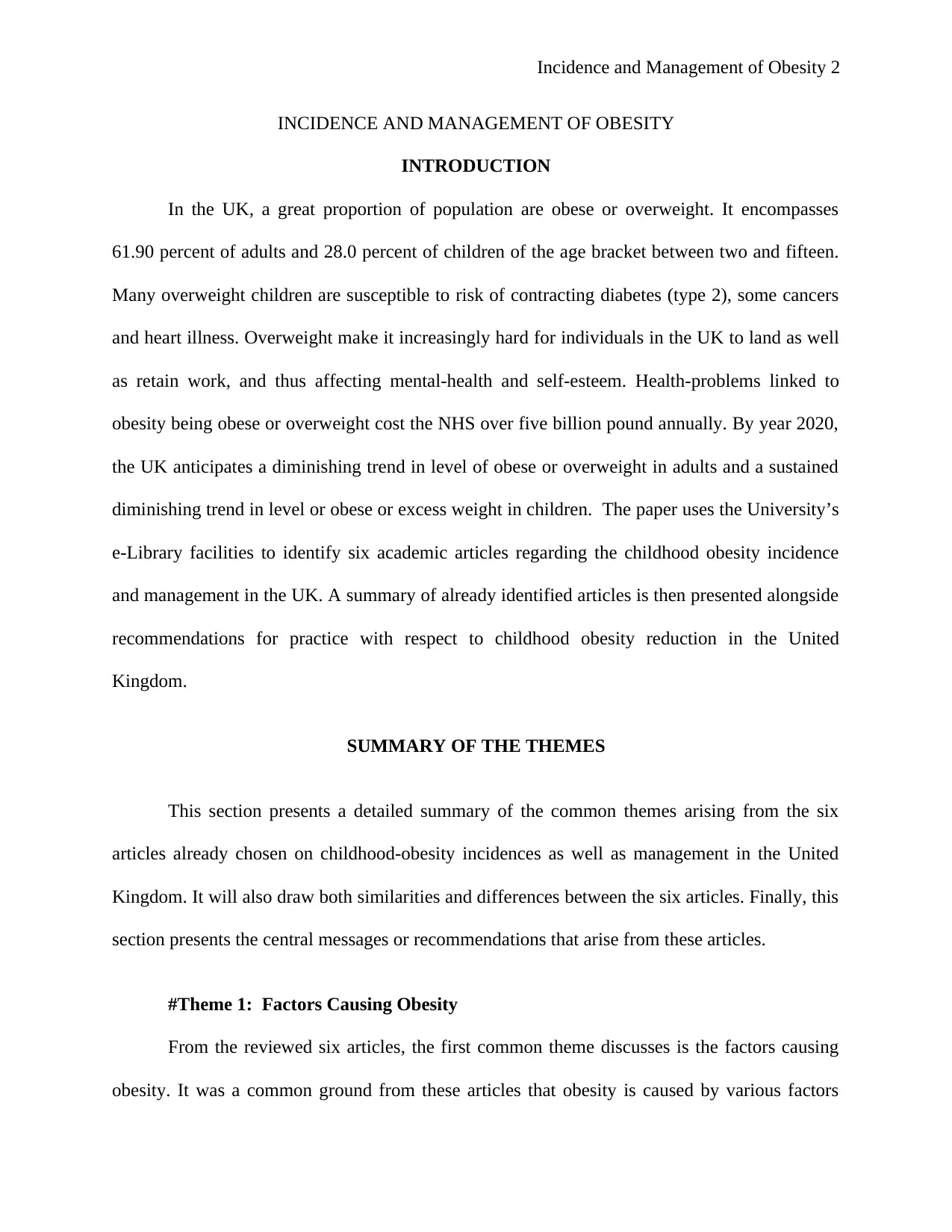
Incidence and Management of Obesity 2
INCIDENCE AND MANAGEMENT OF OBESITY
INTRODUCTION
In the UK, a great proportion of population are obese or overweight. It encompasses
61.90 percent of adults and 28.0 percent of children of the age bracket between two and fifteen.
Many overweight children are susceptible to risk of contracting diabetes (type 2), some cancers
and heart illness. Overweight make it increasingly hard for individuals in the UK to land as well
as retain work, and thus affecting mental-health and self-esteem. Health-problems linked to
obesity being obese or overweight cost the NHS over five billion pound annually. By year 2020,
the UK anticipates a diminishing trend in level of obese or overweight in adults and a sustained
diminishing trend in level or obese or excess weight in children. The paper uses the University’s
e-Library facilities to identify six academic articles regarding the childhood obesity incidence
and management in the UK. A summary of already identified articles is then presented alongside
recommendations for practice with respect to childhood obesity reduction in the United
Kingdom.
SUMMARY OF THE THEMES
This section presents a detailed summary of the common themes arising from the six
articles already chosen on childhood-obesity incidences as well as management in the United
Kingdom. It will also draw both similarities and differences between the six articles. Finally, this
section presents the central messages or recommendations that arise from these articles.
#Theme 1: Factors Causing Obesity
From the reviewed six articles, the first common theme discusses is the factors causing
obesity. It was a common ground from these articles that obesity is caused by various factors
INCIDENCE AND MANAGEMENT OF OBESITY
INTRODUCTION
In the UK, a great proportion of population are obese or overweight. It encompasses
61.90 percent of adults and 28.0 percent of children of the age bracket between two and fifteen.
Many overweight children are susceptible to risk of contracting diabetes (type 2), some cancers
and heart illness. Overweight make it increasingly hard for individuals in the UK to land as well
as retain work, and thus affecting mental-health and self-esteem. Health-problems linked to
obesity being obese or overweight cost the NHS over five billion pound annually. By year 2020,
the UK anticipates a diminishing trend in level of obese or overweight in adults and a sustained
diminishing trend in level or obese or excess weight in children. The paper uses the University’s
e-Library facilities to identify six academic articles regarding the childhood obesity incidence
and management in the UK. A summary of already identified articles is then presented alongside
recommendations for practice with respect to childhood obesity reduction in the United
Kingdom.
SUMMARY OF THE THEMES
This section presents a detailed summary of the common themes arising from the six
articles already chosen on childhood-obesity incidences as well as management in the United
Kingdom. It will also draw both similarities and differences between the six articles. Finally, this
section presents the central messages or recommendations that arise from these articles.
#Theme 1: Factors Causing Obesity
From the reviewed six articles, the first common theme discusses is the factors causing
obesity. It was a common ground from these articles that obesity is caused by various factors
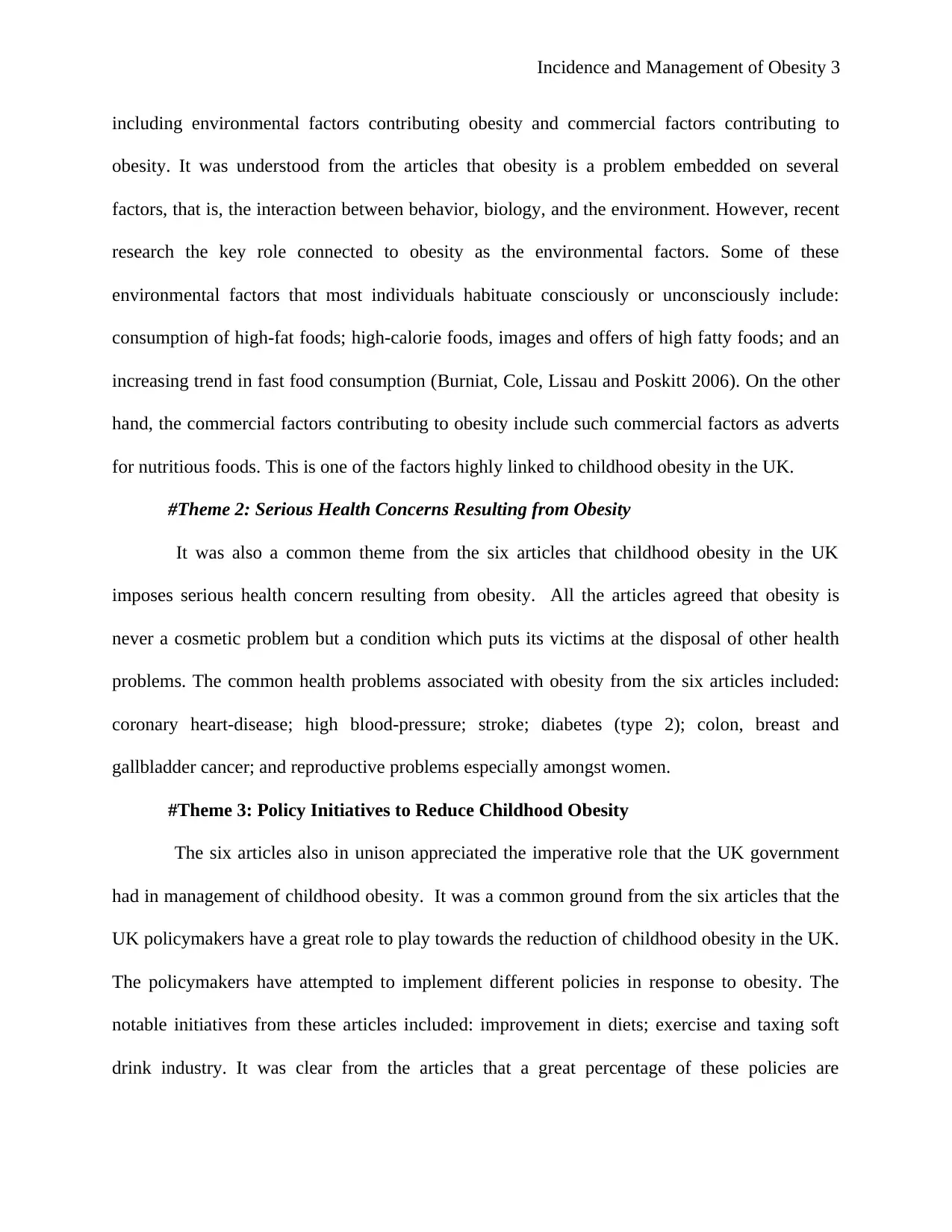
Incidence and Management of Obesity 3
including environmental factors contributing obesity and commercial factors contributing to
obesity. It was understood from the articles that obesity is a problem embedded on several
factors, that is, the interaction between behavior, biology, and the environment. However, recent
research the key role connected to obesity as the environmental factors. Some of these
environmental factors that most individuals habituate consciously or unconsciously include:
consumption of high-fat foods; high-calorie foods, images and offers of high fatty foods; and an
increasing trend in fast food consumption (Burniat, Cole, Lissau and Poskitt 2006). On the other
hand, the commercial factors contributing to obesity include such commercial factors as adverts
for nutritious foods. This is one of the factors highly linked to childhood obesity in the UK.
#Theme 2: Serious Health Concerns Resulting from Obesity
It was also a common theme from the six articles that childhood obesity in the UK
imposes serious health concern resulting from obesity. All the articles agreed that obesity is
never a cosmetic problem but a condition which puts its victims at the disposal of other health
problems. The common health problems associated with obesity from the six articles included:
coronary heart-disease; high blood-pressure; stroke; diabetes (type 2); colon, breast and
gallbladder cancer; and reproductive problems especially amongst women.
#Theme 3: Policy Initiatives to Reduce Childhood Obesity
The six articles also in unison appreciated the imperative role that the UK government
had in management of childhood obesity. It was a common ground from the six articles that the
UK policymakers have a great role to play towards the reduction of childhood obesity in the UK.
The policymakers have attempted to implement different policies in response to obesity. The
notable initiatives from these articles included: improvement in diets; exercise and taxing soft
drink industry. It was clear from the articles that a great percentage of these policies are
including environmental factors contributing obesity and commercial factors contributing to
obesity. It was understood from the articles that obesity is a problem embedded on several
factors, that is, the interaction between behavior, biology, and the environment. However, recent
research the key role connected to obesity as the environmental factors. Some of these
environmental factors that most individuals habituate consciously or unconsciously include:
consumption of high-fat foods; high-calorie foods, images and offers of high fatty foods; and an
increasing trend in fast food consumption (Burniat, Cole, Lissau and Poskitt 2006). On the other
hand, the commercial factors contributing to obesity include such commercial factors as adverts
for nutritious foods. This is one of the factors highly linked to childhood obesity in the UK.
#Theme 2: Serious Health Concerns Resulting from Obesity
It was also a common theme from the six articles that childhood obesity in the UK
imposes serious health concern resulting from obesity. All the articles agreed that obesity is
never a cosmetic problem but a condition which puts its victims at the disposal of other health
problems. The common health problems associated with obesity from the six articles included:
coronary heart-disease; high blood-pressure; stroke; diabetes (type 2); colon, breast and
gallbladder cancer; and reproductive problems especially amongst women.
#Theme 3: Policy Initiatives to Reduce Childhood Obesity
The six articles also in unison appreciated the imperative role that the UK government
had in management of childhood obesity. It was a common ground from the six articles that the
UK policymakers have a great role to play towards the reduction of childhood obesity in the UK.
The policymakers have attempted to implement different policies in response to obesity. The
notable initiatives from these articles included: improvement in diets; exercise and taxing soft
drink industry. It was clear from the articles that a great percentage of these policies are
⊘ This is a preview!⊘
Do you want full access?
Subscribe today to unlock all pages.

Trusted by 1+ million students worldwide
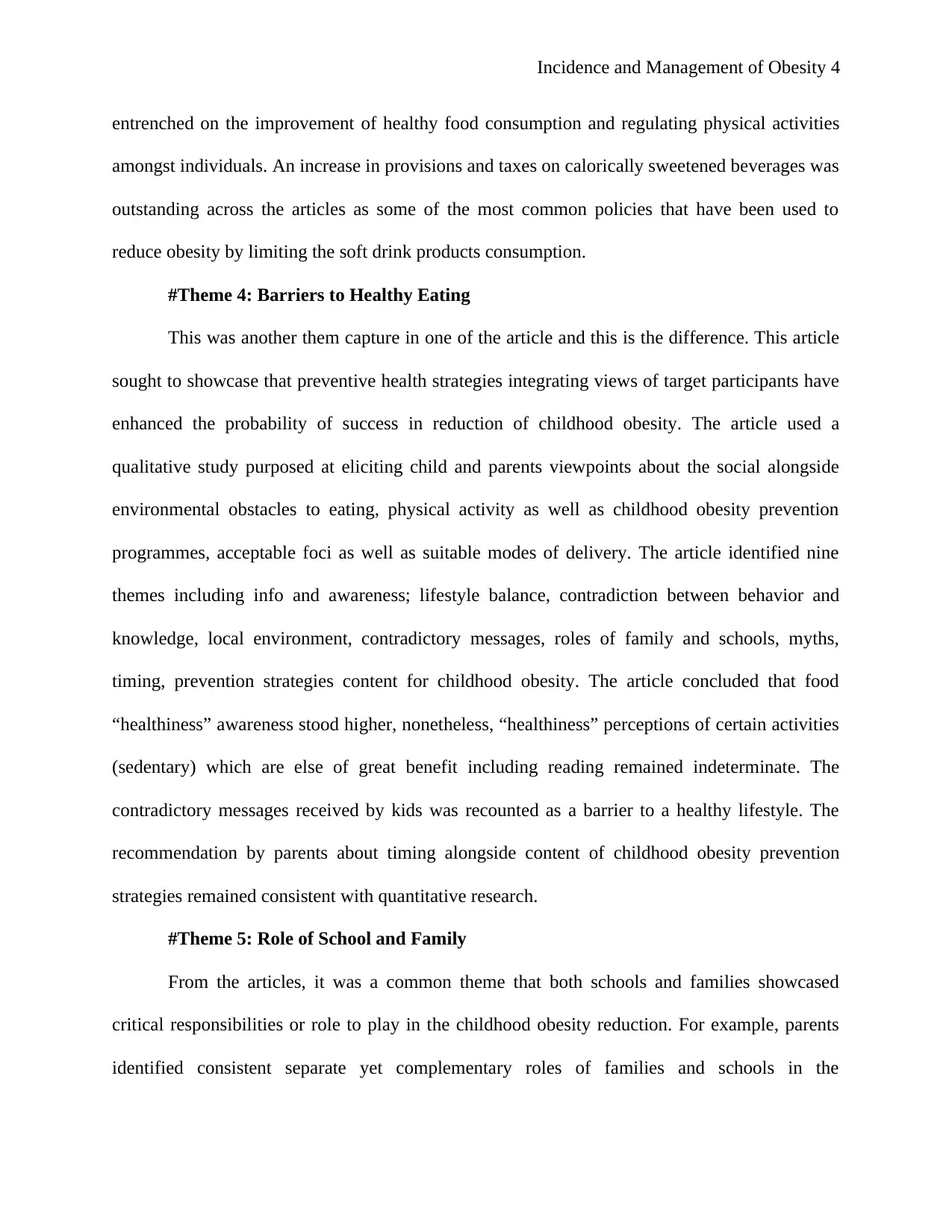
Incidence and Management of Obesity 4
entrenched on the improvement of healthy food consumption and regulating physical activities
amongst individuals. An increase in provisions and taxes on calorically sweetened beverages was
outstanding across the articles as some of the most common policies that have been used to
reduce obesity by limiting the soft drink products consumption.
#Theme 4: Barriers to Healthy Eating
This was another them capture in one of the article and this is the difference. This article
sought to showcase that preventive health strategies integrating views of target participants have
enhanced the probability of success in reduction of childhood obesity. The article used a
qualitative study purposed at eliciting child and parents viewpoints about the social alongside
environmental obstacles to eating, physical activity as well as childhood obesity prevention
programmes, acceptable foci as well as suitable modes of delivery. The article identified nine
themes including info and awareness; lifestyle balance, contradiction between behavior and
knowledge, local environment, contradictory messages, roles of family and schools, myths,
timing, prevention strategies content for childhood obesity. The article concluded that food
“healthiness” awareness stood higher, nonetheless, “healthiness” perceptions of certain activities
(sedentary) which are else of great benefit including reading remained indeterminate. The
contradictory messages received by kids was recounted as a barrier to a healthy lifestyle. The
recommendation by parents about timing alongside content of childhood obesity prevention
strategies remained consistent with quantitative research.
#Theme 5: Role of School and Family
From the articles, it was a common theme that both schools and families showcased
critical responsibilities or role to play in the childhood obesity reduction. For example, parents
identified consistent separate yet complementary roles of families and schools in the
entrenched on the improvement of healthy food consumption and regulating physical activities
amongst individuals. An increase in provisions and taxes on calorically sweetened beverages was
outstanding across the articles as some of the most common policies that have been used to
reduce obesity by limiting the soft drink products consumption.
#Theme 4: Barriers to Healthy Eating
This was another them capture in one of the article and this is the difference. This article
sought to showcase that preventive health strategies integrating views of target participants have
enhanced the probability of success in reduction of childhood obesity. The article used a
qualitative study purposed at eliciting child and parents viewpoints about the social alongside
environmental obstacles to eating, physical activity as well as childhood obesity prevention
programmes, acceptable foci as well as suitable modes of delivery. The article identified nine
themes including info and awareness; lifestyle balance, contradiction between behavior and
knowledge, local environment, contradictory messages, roles of family and schools, myths,
timing, prevention strategies content for childhood obesity. The article concluded that food
“healthiness” awareness stood higher, nonetheless, “healthiness” perceptions of certain activities
(sedentary) which are else of great benefit including reading remained indeterminate. The
contradictory messages received by kids was recounted as a barrier to a healthy lifestyle. The
recommendation by parents about timing alongside content of childhood obesity prevention
strategies remained consistent with quantitative research.
#Theme 5: Role of School and Family
From the articles, it was a common theme that both schools and families showcased
critical responsibilities or role to play in the childhood obesity reduction. For example, parents
identified consistent separate yet complementary roles of families and schools in the
Paraphrase This Document
Need a fresh take? Get an instant paraphrase of this document with our AI Paraphraser
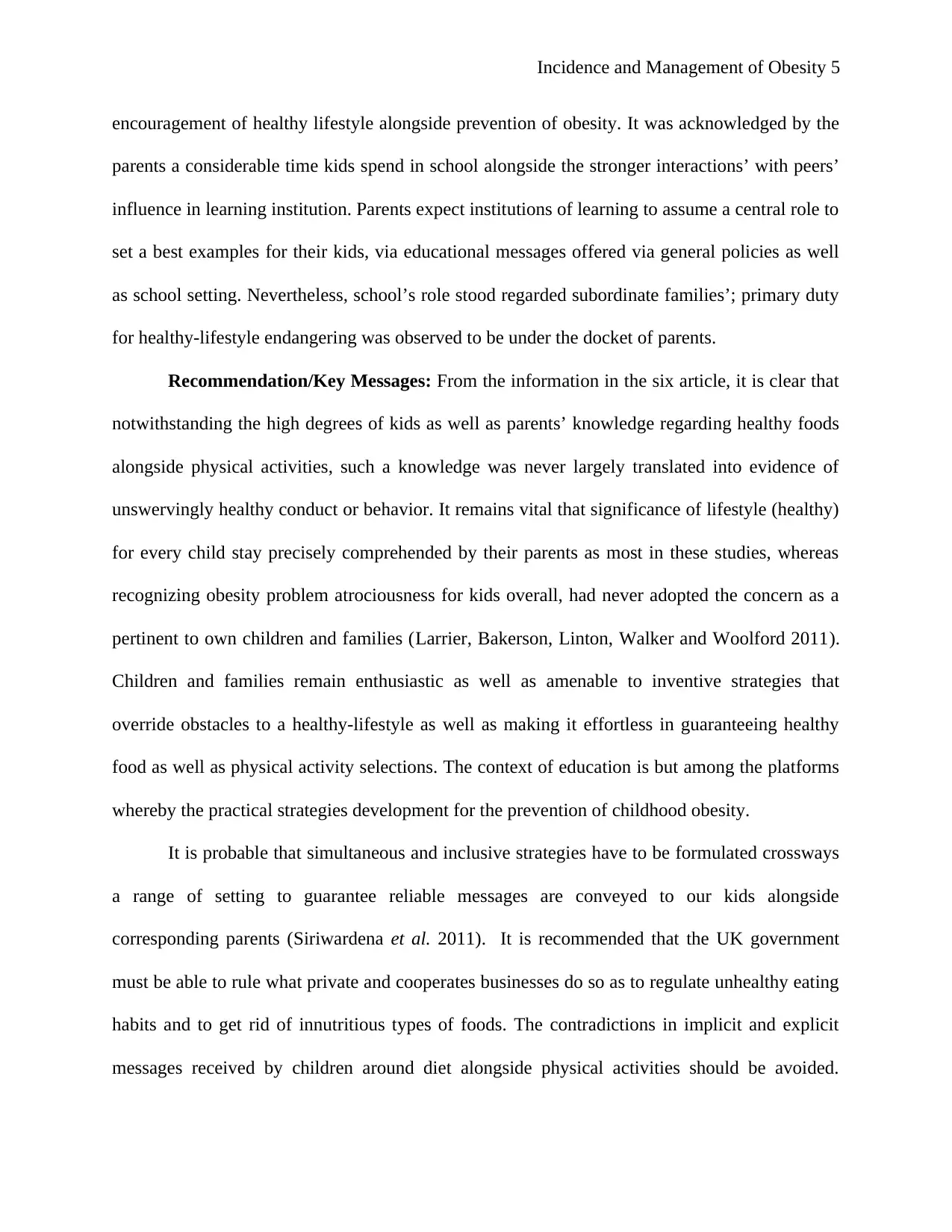
Incidence and Management of Obesity 5
encouragement of healthy lifestyle alongside prevention of obesity. It was acknowledged by the
parents a considerable time kids spend in school alongside the stronger interactions’ with peers’
influence in learning institution. Parents expect institutions of learning to assume a central role to
set a best examples for their kids, via educational messages offered via general policies as well
as school setting. Nevertheless, school’s role stood regarded subordinate families’; primary duty
for healthy-lifestyle endangering was observed to be under the docket of parents.
Recommendation/Key Messages: From the information in the six article, it is clear that
notwithstanding the high degrees of kids as well as parents’ knowledge regarding healthy foods
alongside physical activities, such a knowledge was never largely translated into evidence of
unswervingly healthy conduct or behavior. It remains vital that significance of lifestyle (healthy)
for every child stay precisely comprehended by their parents as most in these studies, whereas
recognizing obesity problem atrociousness for kids overall, had never adopted the concern as a
pertinent to own children and families (Larrier, Bakerson, Linton, Walker and Woolford 2011).
Children and families remain enthusiastic as well as amenable to inventive strategies that
override obstacles to a healthy-lifestyle as well as making it effortless in guaranteeing healthy
food as well as physical activity selections. The context of education is but among the platforms
whereby the practical strategies development for the prevention of childhood obesity.
It is probable that simultaneous and inclusive strategies have to be formulated crossways
a range of setting to guarantee reliable messages are conveyed to our kids alongside
corresponding parents (Siriwardena et al. 2011). It is recommended that the UK government
must be able to rule what private and cooperates businesses do so as to regulate unhealthy eating
habits and to get rid of innutritious types of foods. The contradictions in implicit and explicit
messages received by children around diet alongside physical activities should be avoided.
encouragement of healthy lifestyle alongside prevention of obesity. It was acknowledged by the
parents a considerable time kids spend in school alongside the stronger interactions’ with peers’
influence in learning institution. Parents expect institutions of learning to assume a central role to
set a best examples for their kids, via educational messages offered via general policies as well
as school setting. Nevertheless, school’s role stood regarded subordinate families’; primary duty
for healthy-lifestyle endangering was observed to be under the docket of parents.
Recommendation/Key Messages: From the information in the six article, it is clear that
notwithstanding the high degrees of kids as well as parents’ knowledge regarding healthy foods
alongside physical activities, such a knowledge was never largely translated into evidence of
unswervingly healthy conduct or behavior. It remains vital that significance of lifestyle (healthy)
for every child stay precisely comprehended by their parents as most in these studies, whereas
recognizing obesity problem atrociousness for kids overall, had never adopted the concern as a
pertinent to own children and families (Larrier, Bakerson, Linton, Walker and Woolford 2011).
Children and families remain enthusiastic as well as amenable to inventive strategies that
override obstacles to a healthy-lifestyle as well as making it effortless in guaranteeing healthy
food as well as physical activity selections. The context of education is but among the platforms
whereby the practical strategies development for the prevention of childhood obesity.
It is probable that simultaneous and inclusive strategies have to be formulated crossways
a range of setting to guarantee reliable messages are conveyed to our kids alongside
corresponding parents (Siriwardena et al. 2011). It is recommended that the UK government
must be able to rule what private and cooperates businesses do so as to regulate unhealthy eating
habits and to get rid of innutritious types of foods. The contradictions in implicit and explicit
messages received by children around diet alongside physical activities should be avoided.
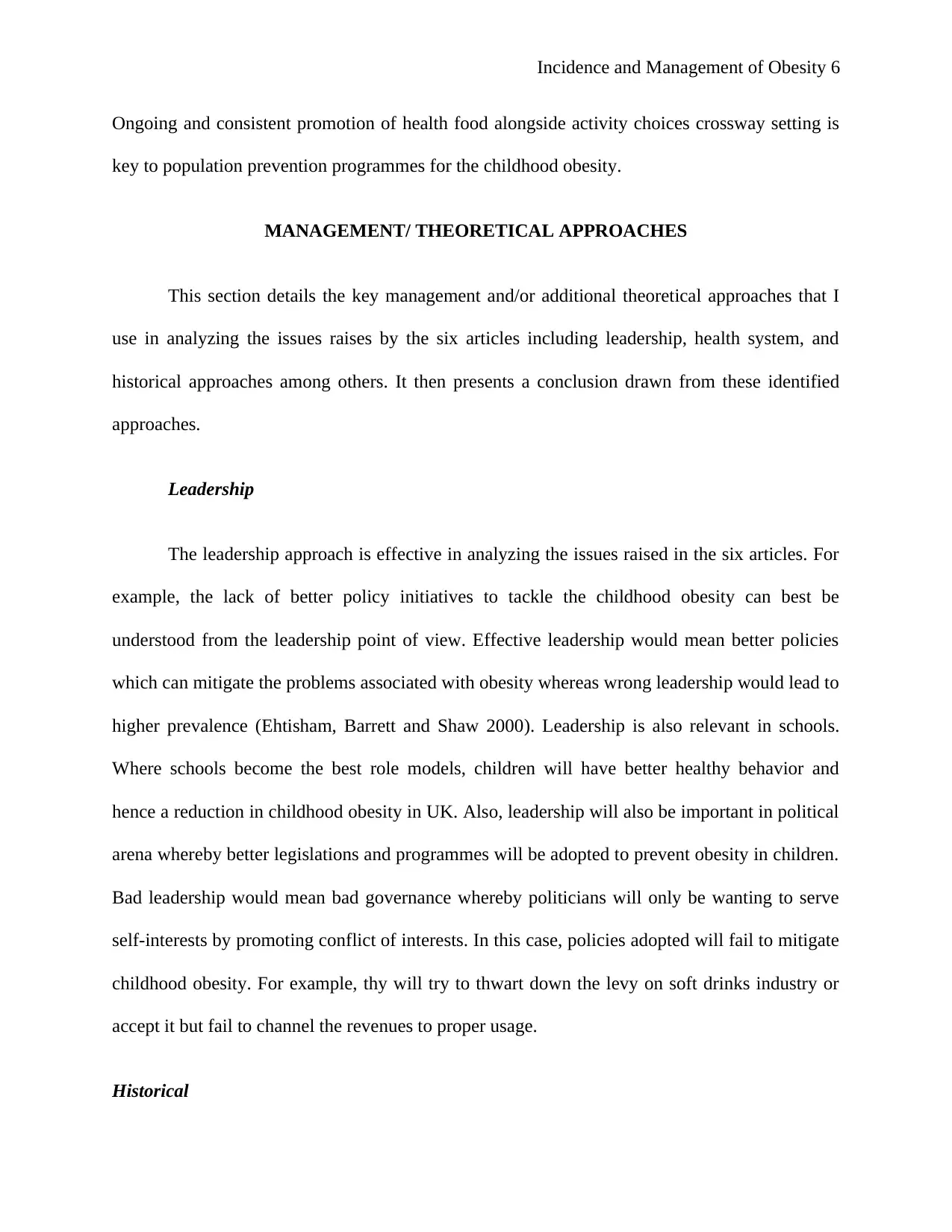
Incidence and Management of Obesity 6
Ongoing and consistent promotion of health food alongside activity choices crossway setting is
key to population prevention programmes for the childhood obesity.
MANAGEMENT/ THEORETICAL APPROACHES
This section details the key management and/or additional theoretical approaches that I
use in analyzing the issues raises by the six articles including leadership, health system, and
historical approaches among others. It then presents a conclusion drawn from these identified
approaches.
Leadership
The leadership approach is effective in analyzing the issues raised in the six articles. For
example, the lack of better policy initiatives to tackle the childhood obesity can best be
understood from the leadership point of view. Effective leadership would mean better policies
which can mitigate the problems associated with obesity whereas wrong leadership would lead to
higher prevalence (Ehtisham, Barrett and Shaw 2000). Leadership is also relevant in schools.
Where schools become the best role models, children will have better healthy behavior and
hence a reduction in childhood obesity in UK. Also, leadership will also be important in political
arena whereby better legislations and programmes will be adopted to prevent obesity in children.
Bad leadership would mean bad governance whereby politicians will only be wanting to serve
self-interests by promoting conflict of interests. In this case, policies adopted will fail to mitigate
childhood obesity. For example, thy will try to thwart down the levy on soft drinks industry or
accept it but fail to channel the revenues to proper usage.
Historical
Ongoing and consistent promotion of health food alongside activity choices crossway setting is
key to population prevention programmes for the childhood obesity.
MANAGEMENT/ THEORETICAL APPROACHES
This section details the key management and/or additional theoretical approaches that I
use in analyzing the issues raises by the six articles including leadership, health system, and
historical approaches among others. It then presents a conclusion drawn from these identified
approaches.
Leadership
The leadership approach is effective in analyzing the issues raised in the six articles. For
example, the lack of better policy initiatives to tackle the childhood obesity can best be
understood from the leadership point of view. Effective leadership would mean better policies
which can mitigate the problems associated with obesity whereas wrong leadership would lead to
higher prevalence (Ehtisham, Barrett and Shaw 2000). Leadership is also relevant in schools.
Where schools become the best role models, children will have better healthy behavior and
hence a reduction in childhood obesity in UK. Also, leadership will also be important in political
arena whereby better legislations and programmes will be adopted to prevent obesity in children.
Bad leadership would mean bad governance whereby politicians will only be wanting to serve
self-interests by promoting conflict of interests. In this case, policies adopted will fail to mitigate
childhood obesity. For example, thy will try to thwart down the levy on soft drinks industry or
accept it but fail to channel the revenues to proper usage.
Historical
⊘ This is a preview!⊘
Do you want full access?
Subscribe today to unlock all pages.

Trusted by 1+ million students worldwide
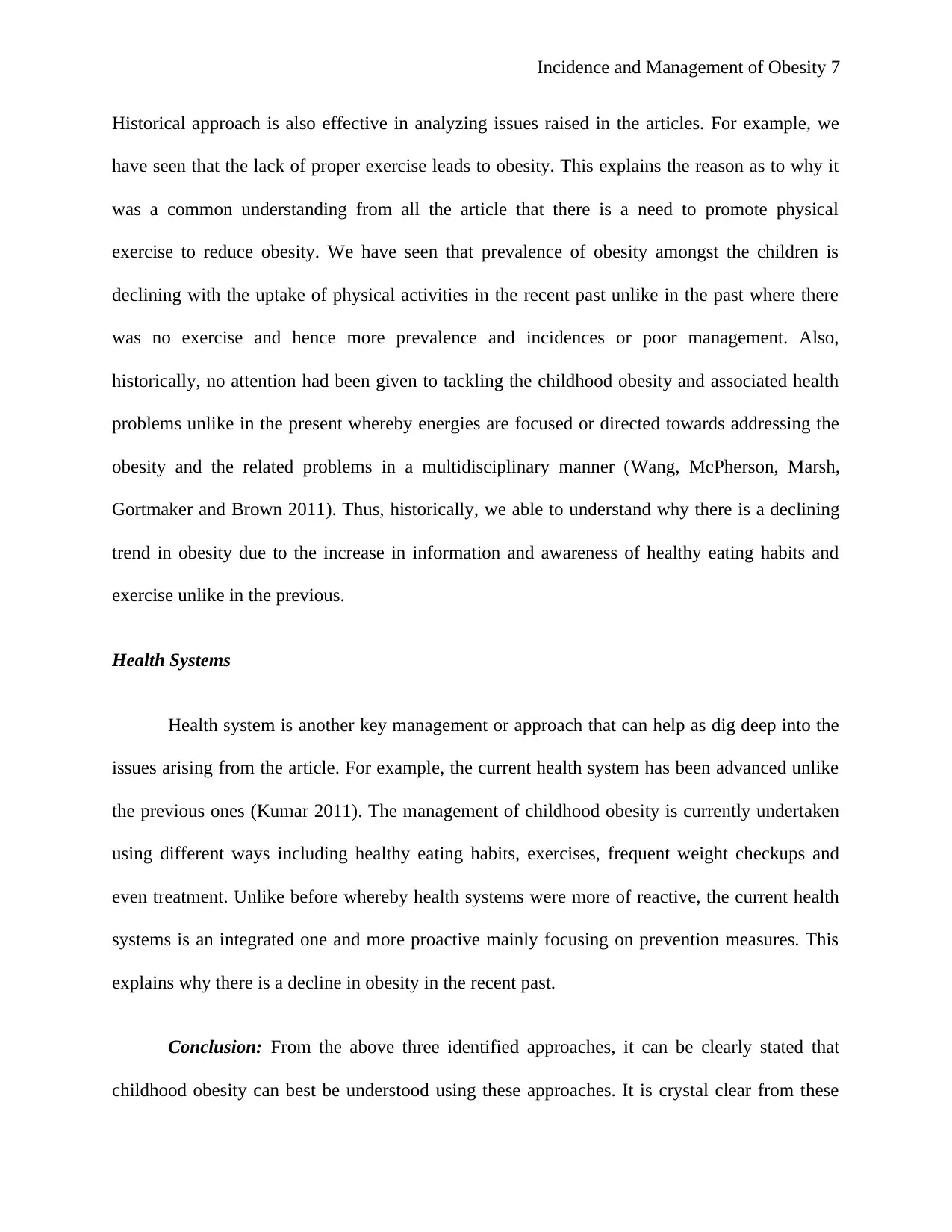
Incidence and Management of Obesity 7
Historical approach is also effective in analyzing issues raised in the articles. For example, we
have seen that the lack of proper exercise leads to obesity. This explains the reason as to why it
was a common understanding from all the article that there is a need to promote physical
exercise to reduce obesity. We have seen that prevalence of obesity amongst the children is
declining with the uptake of physical activities in the recent past unlike in the past where there
was no exercise and hence more prevalence and incidences or poor management. Also,
historically, no attention had been given to tackling the childhood obesity and associated health
problems unlike in the present whereby energies are focused or directed towards addressing the
obesity and the related problems in a multidisciplinary manner (Wang, McPherson, Marsh,
Gortmaker and Brown 2011). Thus, historically, we able to understand why there is a declining
trend in obesity due to the increase in information and awareness of healthy eating habits and
exercise unlike in the previous.
Health Systems
Health system is another key management or approach that can help as dig deep into the
issues arising from the article. For example, the current health system has been advanced unlike
the previous ones (Kumar 2011). The management of childhood obesity is currently undertaken
using different ways including healthy eating habits, exercises, frequent weight checkups and
even treatment. Unlike before whereby health systems were more of reactive, the current health
systems is an integrated one and more proactive mainly focusing on prevention measures. This
explains why there is a decline in obesity in the recent past.
Conclusion: From the above three identified approaches, it can be clearly stated that
childhood obesity can best be understood using these approaches. It is crystal clear from these
Historical approach is also effective in analyzing issues raised in the articles. For example, we
have seen that the lack of proper exercise leads to obesity. This explains the reason as to why it
was a common understanding from all the article that there is a need to promote physical
exercise to reduce obesity. We have seen that prevalence of obesity amongst the children is
declining with the uptake of physical activities in the recent past unlike in the past where there
was no exercise and hence more prevalence and incidences or poor management. Also,
historically, no attention had been given to tackling the childhood obesity and associated health
problems unlike in the present whereby energies are focused or directed towards addressing the
obesity and the related problems in a multidisciplinary manner (Wang, McPherson, Marsh,
Gortmaker and Brown 2011). Thus, historically, we able to understand why there is a declining
trend in obesity due to the increase in information and awareness of healthy eating habits and
exercise unlike in the previous.
Health Systems
Health system is another key management or approach that can help as dig deep into the
issues arising from the article. For example, the current health system has been advanced unlike
the previous ones (Kumar 2011). The management of childhood obesity is currently undertaken
using different ways including healthy eating habits, exercises, frequent weight checkups and
even treatment. Unlike before whereby health systems were more of reactive, the current health
systems is an integrated one and more proactive mainly focusing on prevention measures. This
explains why there is a decline in obesity in the recent past.
Conclusion: From the above three identified approaches, it can be clearly stated that
childhood obesity can best be understood using these approaches. It is crystal clear from these
Paraphrase This Document
Need a fresh take? Get an instant paraphrase of this document with our AI Paraphraser
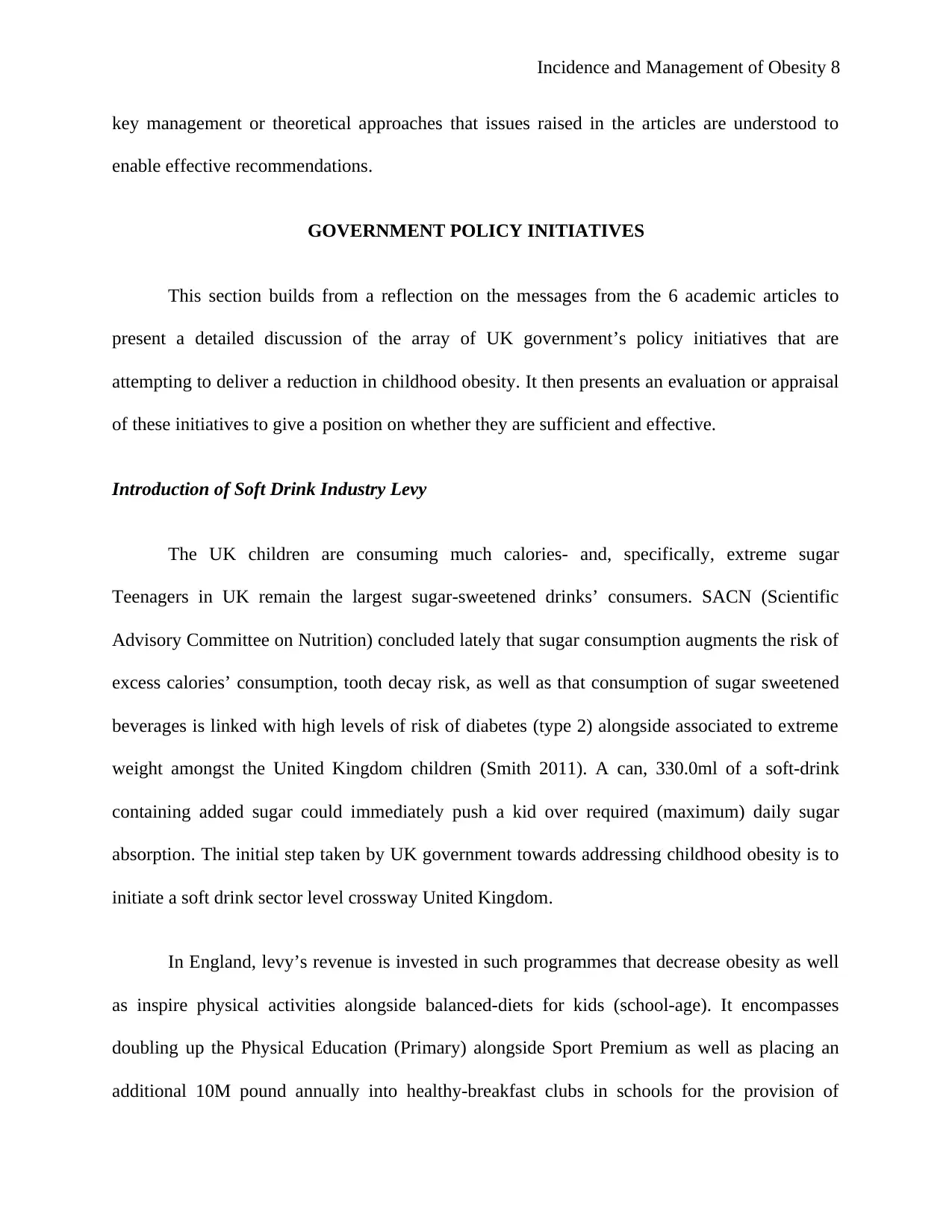
Incidence and Management of Obesity 8
key management or theoretical approaches that issues raised in the articles are understood to
enable effective recommendations.
GOVERNMENT POLICY INITIATIVES
This section builds from a reflection on the messages from the 6 academic articles to
present a detailed discussion of the array of UK government’s policy initiatives that are
attempting to deliver a reduction in childhood obesity. It then presents an evaluation or appraisal
of these initiatives to give a position on whether they are sufficient and effective.
Introduction of Soft Drink Industry Levy
The UK children are consuming much calories- and, specifically, extreme sugar
Teenagers in UK remain the largest sugar-sweetened drinks’ consumers. SACN (Scientific
Advisory Committee on Nutrition) concluded lately that sugar consumption augments the risk of
excess calories’ consumption, tooth decay risk, as well as that consumption of sugar sweetened
beverages is linked with high levels of risk of diabetes (type 2) alongside associated to extreme
weight amongst the United Kingdom children (Smith 2011). A can, 330.0ml of a soft-drink
containing added sugar could immediately push a kid over required (maximum) daily sugar
absorption. The initial step taken by UK government towards addressing childhood obesity is to
initiate a soft drink sector level crossway United Kingdom.
In England, levy’s revenue is invested in such programmes that decrease obesity as well
as inspire physical activities alongside balanced-diets for kids (school-age). It encompasses
doubling up the Physical Education (Primary) alongside Sport Premium as well as placing an
additional 10M pound annually into healthy-breakfast clubs in schools for the provision of
key management or theoretical approaches that issues raised in the articles are understood to
enable effective recommendations.
GOVERNMENT POLICY INITIATIVES
This section builds from a reflection on the messages from the 6 academic articles to
present a detailed discussion of the array of UK government’s policy initiatives that are
attempting to deliver a reduction in childhood obesity. It then presents an evaluation or appraisal
of these initiatives to give a position on whether they are sufficient and effective.
Introduction of Soft Drink Industry Levy
The UK children are consuming much calories- and, specifically, extreme sugar
Teenagers in UK remain the largest sugar-sweetened drinks’ consumers. SACN (Scientific
Advisory Committee on Nutrition) concluded lately that sugar consumption augments the risk of
excess calories’ consumption, tooth decay risk, as well as that consumption of sugar sweetened
beverages is linked with high levels of risk of diabetes (type 2) alongside associated to extreme
weight amongst the United Kingdom children (Smith 2011). A can, 330.0ml of a soft-drink
containing added sugar could immediately push a kid over required (maximum) daily sugar
absorption. The initial step taken by UK government towards addressing childhood obesity is to
initiate a soft drink sector level crossway United Kingdom.
In England, levy’s revenue is invested in such programmes that decrease obesity as well
as inspire physical activities alongside balanced-diets for kids (school-age). It encompasses
doubling up the Physical Education (Primary) alongside Sport Premium as well as placing an
additional 10M pound annually into healthy-breakfast clubs in schools for the provision of
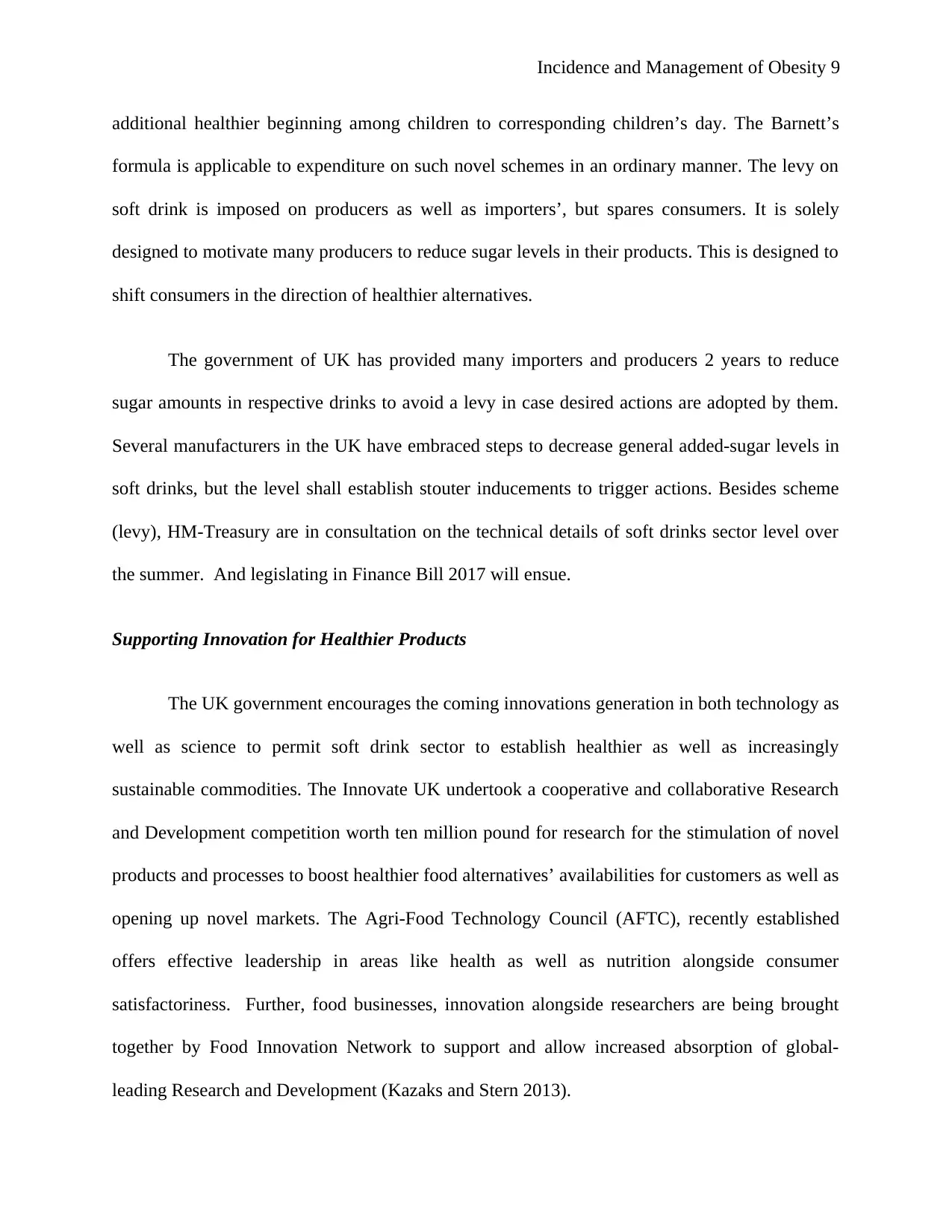
Incidence and Management of Obesity 9
additional healthier beginning among children to corresponding children’s day. The Barnett’s
formula is applicable to expenditure on such novel schemes in an ordinary manner. The levy on
soft drink is imposed on producers as well as importers’, but spares consumers. It is solely
designed to motivate many producers to reduce sugar levels in their products. This is designed to
shift consumers in the direction of healthier alternatives.
The government of UK has provided many importers and producers 2 years to reduce
sugar amounts in respective drinks to avoid a levy in case desired actions are adopted by them.
Several manufacturers in the UK have embraced steps to decrease general added-sugar levels in
soft drinks, but the level shall establish stouter inducements to trigger actions. Besides scheme
(levy), HM-Treasury are in consultation on the technical details of soft drinks sector level over
the summer. And legislating in Finance Bill 2017 will ensue.
Supporting Innovation for Healthier Products
The UK government encourages the coming innovations generation in both technology as
well as science to permit soft drink sector to establish healthier as well as increasingly
sustainable commodities. The Innovate UK undertook a cooperative and collaborative Research
and Development competition worth ten million pound for research for the stimulation of novel
products and processes to boost healthier food alternatives’ availabilities for customers as well as
opening up novel markets. The Agri-Food Technology Council (AFTC), recently established
offers effective leadership in areas like health as well as nutrition alongside consumer
satisfactoriness. Further, food businesses, innovation alongside researchers are being brought
together by Food Innovation Network to support and allow increased absorption of global-
leading Research and Development (Kazaks and Stern 2013).
additional healthier beginning among children to corresponding children’s day. The Barnett’s
formula is applicable to expenditure on such novel schemes in an ordinary manner. The levy on
soft drink is imposed on producers as well as importers’, but spares consumers. It is solely
designed to motivate many producers to reduce sugar levels in their products. This is designed to
shift consumers in the direction of healthier alternatives.
The government of UK has provided many importers and producers 2 years to reduce
sugar amounts in respective drinks to avoid a levy in case desired actions are adopted by them.
Several manufacturers in the UK have embraced steps to decrease general added-sugar levels in
soft drinks, but the level shall establish stouter inducements to trigger actions. Besides scheme
(levy), HM-Treasury are in consultation on the technical details of soft drinks sector level over
the summer. And legislating in Finance Bill 2017 will ensue.
Supporting Innovation for Healthier Products
The UK government encourages the coming innovations generation in both technology as
well as science to permit soft drink sector to establish healthier as well as increasingly
sustainable commodities. The Innovate UK undertook a cooperative and collaborative Research
and Development competition worth ten million pound for research for the stimulation of novel
products and processes to boost healthier food alternatives’ availabilities for customers as well as
opening up novel markets. The Agri-Food Technology Council (AFTC), recently established
offers effective leadership in areas like health as well as nutrition alongside consumer
satisfactoriness. Further, food businesses, innovation alongside researchers are being brought
together by Food Innovation Network to support and allow increased absorption of global-
leading Research and Development (Kazaks and Stern 2013).
⊘ This is a preview!⊘
Do you want full access?
Subscribe today to unlock all pages.

Trusted by 1+ million students worldwide
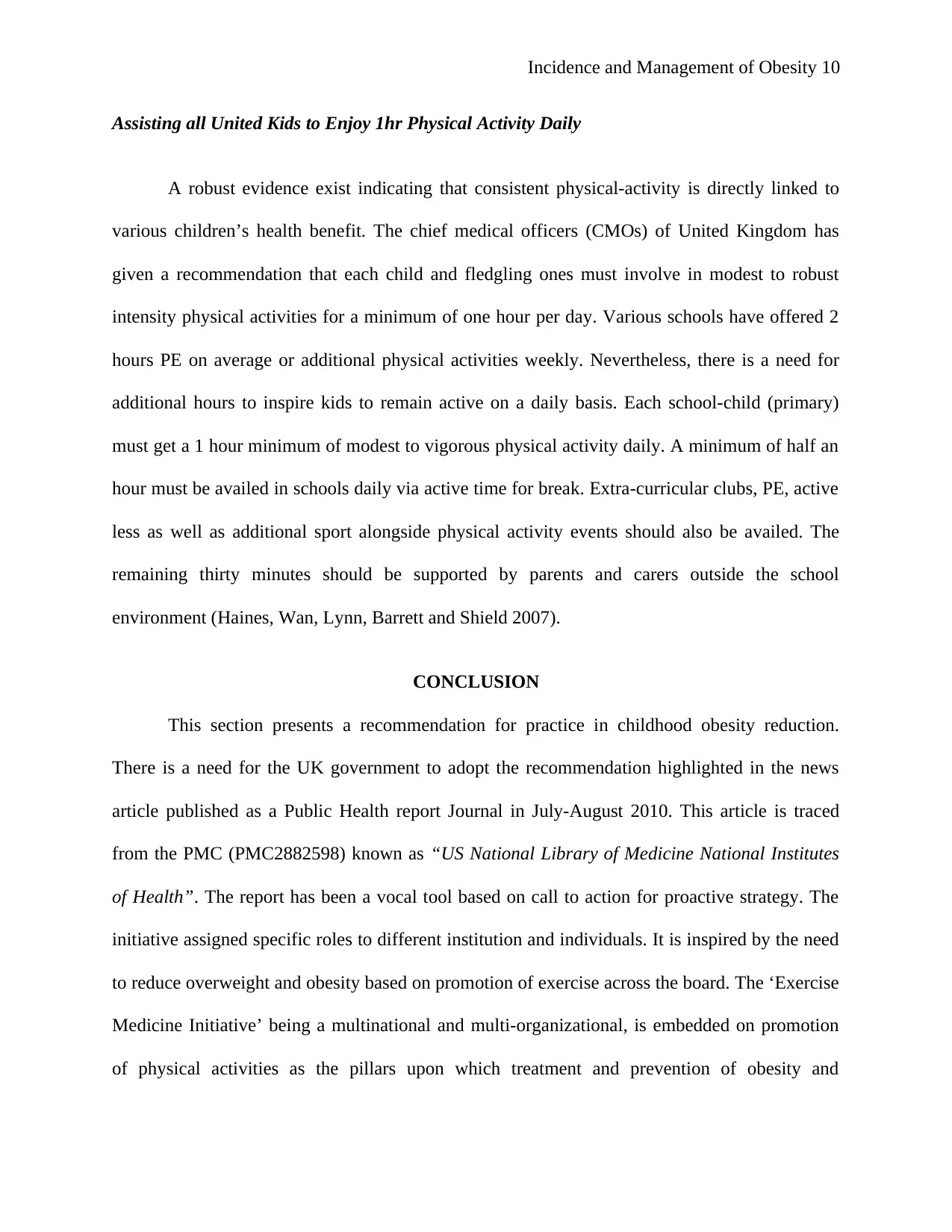
Incidence and Management of Obesity 10
Assisting all United Kids to Enjoy 1hr Physical Activity Daily
A robust evidence exist indicating that consistent physical-activity is directly linked to
various children’s health benefit. The chief medical officers (CMOs) of United Kingdom has
given a recommendation that each child and fledgling ones must involve in modest to robust
intensity physical activities for a minimum of one hour per day. Various schools have offered 2
hours PE on average or additional physical activities weekly. Nevertheless, there is a need for
additional hours to inspire kids to remain active on a daily basis. Each school-child (primary)
must get a 1 hour minimum of modest to vigorous physical activity daily. A minimum of half an
hour must be availed in schools daily via active time for break. Extra-curricular clubs, PE, active
less as well as additional sport alongside physical activity events should also be availed. The
remaining thirty minutes should be supported by parents and carers outside the school
environment (Haines, Wan, Lynn, Barrett and Shield 2007).
CONCLUSION
This section presents a recommendation for practice in childhood obesity reduction.
There is a need for the UK government to adopt the recommendation highlighted in the news
article published as a Public Health report Journal in July-August 2010. This article is traced
from the PMC (PMC2882598) known as “US National Library of Medicine National Institutes
of Health”. The report has been a vocal tool based on call to action for proactive strategy. The
initiative assigned specific roles to different institution and individuals. It is inspired by the need
to reduce overweight and obesity based on promotion of exercise across the board. The ‘Exercise
Medicine Initiative’ being a multinational and multi-organizational, is embedded on promotion
of physical activities as the pillars upon which treatment and prevention of obesity and
Assisting all United Kids to Enjoy 1hr Physical Activity Daily
A robust evidence exist indicating that consistent physical-activity is directly linked to
various children’s health benefit. The chief medical officers (CMOs) of United Kingdom has
given a recommendation that each child and fledgling ones must involve in modest to robust
intensity physical activities for a minimum of one hour per day. Various schools have offered 2
hours PE on average or additional physical activities weekly. Nevertheless, there is a need for
additional hours to inspire kids to remain active on a daily basis. Each school-child (primary)
must get a 1 hour minimum of modest to vigorous physical activity daily. A minimum of half an
hour must be availed in schools daily via active time for break. Extra-curricular clubs, PE, active
less as well as additional sport alongside physical activity events should also be availed. The
remaining thirty minutes should be supported by parents and carers outside the school
environment (Haines, Wan, Lynn, Barrett and Shield 2007).
CONCLUSION
This section presents a recommendation for practice in childhood obesity reduction.
There is a need for the UK government to adopt the recommendation highlighted in the news
article published as a Public Health report Journal in July-August 2010. This article is traced
from the PMC (PMC2882598) known as “US National Library of Medicine National Institutes
of Health”. The report has been a vocal tool based on call to action for proactive strategy. The
initiative assigned specific roles to different institution and individuals. It is inspired by the need
to reduce overweight and obesity based on promotion of exercise across the board. The ‘Exercise
Medicine Initiative’ being a multinational and multi-organizational, is embedded on promotion
of physical activities as the pillars upon which treatment and prevention of obesity and
Paraphrase This Document
Need a fresh take? Get an instant paraphrase of this document with our AI Paraphraser
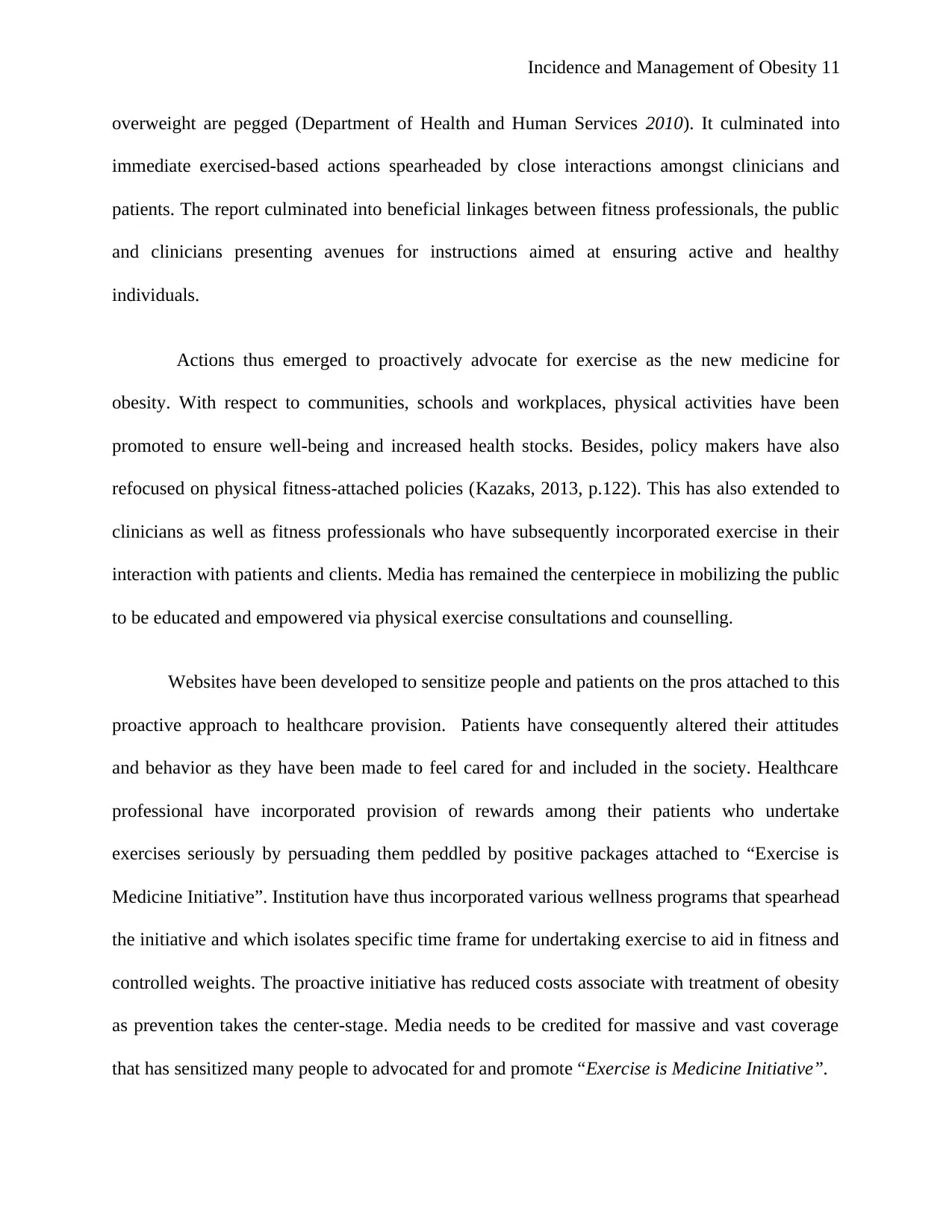
Incidence and Management of Obesity 11
overweight are pegged (Department of Health and Human Services 2010). It culminated into
immediate exercised-based actions spearheaded by close interactions amongst clinicians and
patients. The report culminated into beneficial linkages between fitness professionals, the public
and clinicians presenting avenues for instructions aimed at ensuring active and healthy
individuals.
Actions thus emerged to proactively advocate for exercise as the new medicine for
obesity. With respect to communities, schools and workplaces, physical activities have been
promoted to ensure well-being and increased health stocks. Besides, policy makers have also
refocused on physical fitness-attached policies (Kazaks, 2013, p.122). This has also extended to
clinicians as well as fitness professionals who have subsequently incorporated exercise in their
interaction with patients and clients. Media has remained the centerpiece in mobilizing the public
to be educated and empowered via physical exercise consultations and counselling.
Websites have been developed to sensitize people and patients on the pros attached to this
proactive approach to healthcare provision. Patients have consequently altered their attitudes
and behavior as they have been made to feel cared for and included in the society. Healthcare
professional have incorporated provision of rewards among their patients who undertake
exercises seriously by persuading them peddled by positive packages attached to “Exercise is
Medicine Initiative”. Institution have thus incorporated various wellness programs that spearhead
the initiative and which isolates specific time frame for undertaking exercise to aid in fitness and
controlled weights. The proactive initiative has reduced costs associate with treatment of obesity
as prevention takes the center-stage. Media needs to be credited for massive and vast coverage
that has sensitized many people to advocated for and promote “Exercise is Medicine Initiative”.
overweight are pegged (Department of Health and Human Services 2010). It culminated into
immediate exercised-based actions spearheaded by close interactions amongst clinicians and
patients. The report culminated into beneficial linkages between fitness professionals, the public
and clinicians presenting avenues for instructions aimed at ensuring active and healthy
individuals.
Actions thus emerged to proactively advocate for exercise as the new medicine for
obesity. With respect to communities, schools and workplaces, physical activities have been
promoted to ensure well-being and increased health stocks. Besides, policy makers have also
refocused on physical fitness-attached policies (Kazaks, 2013, p.122). This has also extended to
clinicians as well as fitness professionals who have subsequently incorporated exercise in their
interaction with patients and clients. Media has remained the centerpiece in mobilizing the public
to be educated and empowered via physical exercise consultations and counselling.
Websites have been developed to sensitize people and patients on the pros attached to this
proactive approach to healthcare provision. Patients have consequently altered their attitudes
and behavior as they have been made to feel cared for and included in the society. Healthcare
professional have incorporated provision of rewards among their patients who undertake
exercises seriously by persuading them peddled by positive packages attached to “Exercise is
Medicine Initiative”. Institution have thus incorporated various wellness programs that spearhead
the initiative and which isolates specific time frame for undertaking exercise to aid in fitness and
controlled weights. The proactive initiative has reduced costs associate with treatment of obesity
as prevention takes the center-stage. Media needs to be credited for massive and vast coverage
that has sensitized many people to advocated for and promote “Exercise is Medicine Initiative”.
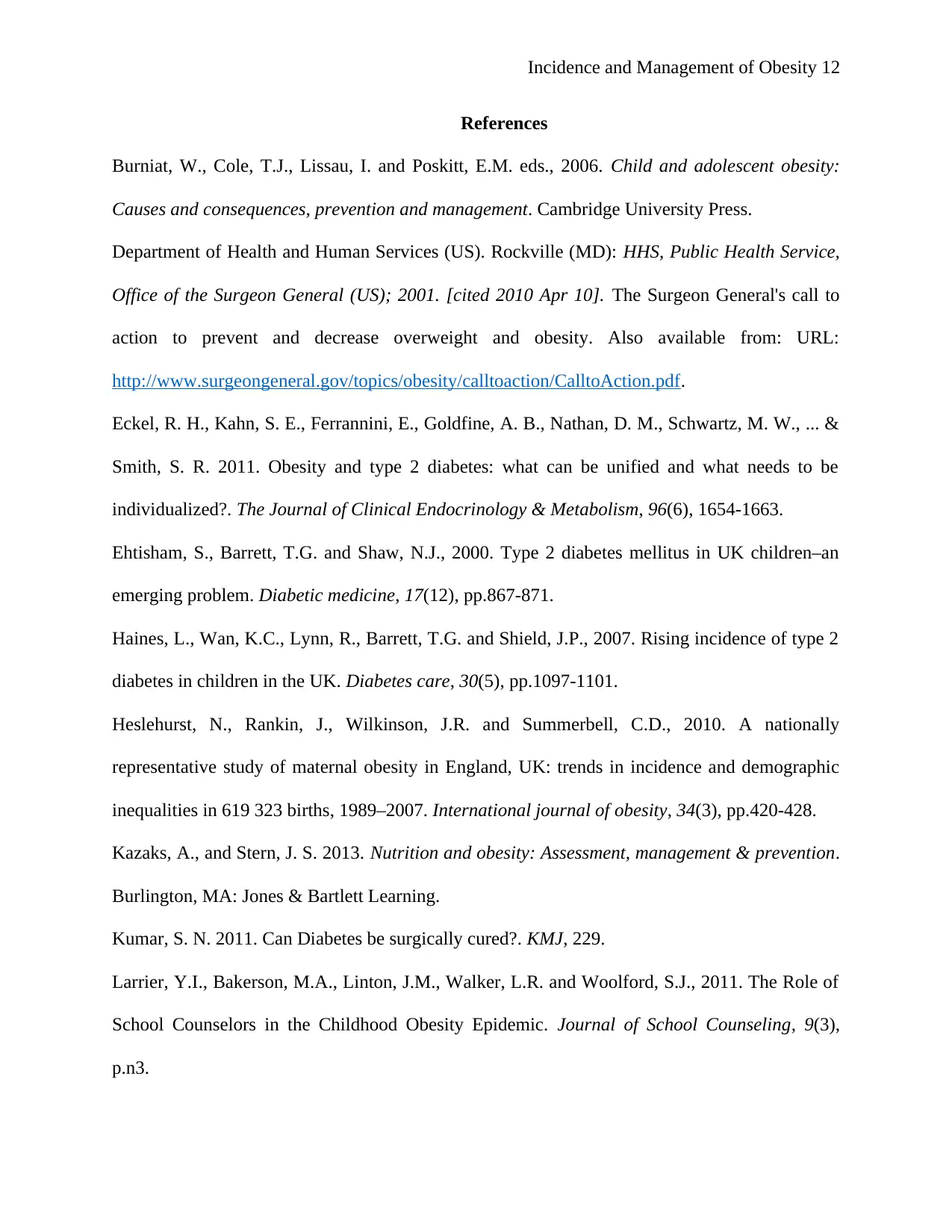
Incidence and Management of Obesity 12
References
Burniat, W., Cole, T.J., Lissau, I. and Poskitt, E.M. eds., 2006. Child and adolescent obesity:
Causes and consequences, prevention and management. Cambridge University Press.
Department of Health and Human Services (US). Rockville (MD): HHS, Public Health Service,
Office of the Surgeon General (US); 2001. [cited 2010 Apr 10]. The Surgeon General's call to
action to prevent and decrease overweight and obesity. Also available from: URL:
http://www.surgeongeneral.gov/topics/obesity/calltoaction/CalltoAction.pdf.
Eckel, R. H., Kahn, S. E., Ferrannini, E., Goldfine, A. B., Nathan, D. M., Schwartz, M. W., ... &
Smith, S. R. 2011. Obesity and type 2 diabetes: what can be unified and what needs to be
individualized?. The Journal of Clinical Endocrinology & Metabolism, 96(6), 1654-1663.
Ehtisham, S., Barrett, T.G. and Shaw, N.J., 2000. Type 2 diabetes mellitus in UK children–an
emerging problem. Diabetic medicine, 17(12), pp.867-871.
Haines, L., Wan, K.C., Lynn, R., Barrett, T.G. and Shield, J.P., 2007. Rising incidence of type 2
diabetes in children in the UK. Diabetes care, 30(5), pp.1097-1101.
Heslehurst, N., Rankin, J., Wilkinson, J.R. and Summerbell, C.D., 2010. A nationally
representative study of maternal obesity in England, UK: trends in incidence and demographic
inequalities in 619 323 births, 1989–2007. International journal of obesity, 34(3), pp.420-428.
Kazaks, A., and Stern, J. S. 2013. Nutrition and obesity: Assessment, management & prevention.
Burlington, MA: Jones & Bartlett Learning.
Kumar, S. N. 2011. Can Diabetes be surgically cured?. KMJ, 229.
Larrier, Y.I., Bakerson, M.A., Linton, J.M., Walker, L.R. and Woolford, S.J., 2011. The Role of
School Counselors in the Childhood Obesity Epidemic. Journal of School Counseling, 9(3),
p.n3.
References
Burniat, W., Cole, T.J., Lissau, I. and Poskitt, E.M. eds., 2006. Child and adolescent obesity:
Causes and consequences, prevention and management. Cambridge University Press.
Department of Health and Human Services (US). Rockville (MD): HHS, Public Health Service,
Office of the Surgeon General (US); 2001. [cited 2010 Apr 10]. The Surgeon General's call to
action to prevent and decrease overweight and obesity. Also available from: URL:
http://www.surgeongeneral.gov/topics/obesity/calltoaction/CalltoAction.pdf.
Eckel, R. H., Kahn, S. E., Ferrannini, E., Goldfine, A. B., Nathan, D. M., Schwartz, M. W., ... &
Smith, S. R. 2011. Obesity and type 2 diabetes: what can be unified and what needs to be
individualized?. The Journal of Clinical Endocrinology & Metabolism, 96(6), 1654-1663.
Ehtisham, S., Barrett, T.G. and Shaw, N.J., 2000. Type 2 diabetes mellitus in UK children–an
emerging problem. Diabetic medicine, 17(12), pp.867-871.
Haines, L., Wan, K.C., Lynn, R., Barrett, T.G. and Shield, J.P., 2007. Rising incidence of type 2
diabetes in children in the UK. Diabetes care, 30(5), pp.1097-1101.
Heslehurst, N., Rankin, J., Wilkinson, J.R. and Summerbell, C.D., 2010. A nationally
representative study of maternal obesity in England, UK: trends in incidence and demographic
inequalities in 619 323 births, 1989–2007. International journal of obesity, 34(3), pp.420-428.
Kazaks, A., and Stern, J. S. 2013. Nutrition and obesity: Assessment, management & prevention.
Burlington, MA: Jones & Bartlett Learning.
Kumar, S. N. 2011. Can Diabetes be surgically cured?. KMJ, 229.
Larrier, Y.I., Bakerson, M.A., Linton, J.M., Walker, L.R. and Woolford, S.J., 2011. The Role of
School Counselors in the Childhood Obesity Epidemic. Journal of School Counseling, 9(3),
p.n3.
⊘ This is a preview!⊘
Do you want full access?
Subscribe today to unlock all pages.

Trusted by 1+ million students worldwide
1 out of 13
Related Documents
Your All-in-One AI-Powered Toolkit for Academic Success.
+13062052269
info@desklib.com
Available 24*7 on WhatsApp / Email
![[object Object]](/_next/static/media/star-bottom.7253800d.svg)
Unlock your academic potential
Copyright © 2020–2025 A2Z Services. All Rights Reserved. Developed and managed by ZUCOL.





